
Monochamus is a genus of longhorn beetles found throughout the world. They are commonly known as sawyer beetles or sawyers, as their larvae bore into dead or dying trees, especially conifers such as pines. They are the type genus of the Monochamini, a tribe in the huge long-horned beetle subfamily Lamiinae, but typically included in the Lamiini today.

The Kerry slug or Kerry spotted slug is a species of terrestrial, pulmonate, gastropod mollusc. It is a medium-to-large sized, air-breathing land slug in the family of roundback slugs, Arionidae.
Pristimantis maculosus is a species of frog in the family Craugastoridae. It is endemic to Colombia and is only known from few localities in the Cordillera Central in Caldas, Antioquia, and Quindío Departments. The specific name maculosus is Latin for "dappled" or "spotted" and refers to the pale spots on the hidden surfaces of this species. Common name spotted robber frog has been coined for it.

The red-backed buttonquail is a species of bird in the family Turnicidae. It is found in Australia, Indonesia, Papua New Guinea, the Philippines and the Solomon Islands. Other names by which it is known in different parts of its range include black-backed, black-spotted and orange-breasted buttonquail. There are fourteen recognised subspecies.
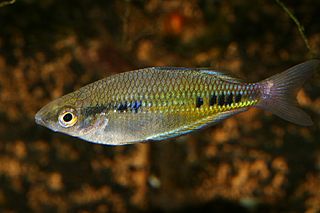
The spotted rainbowfish is a species of rainbowfish in the subfamily Melanotaeniinae. It is endemic to the river systems of the Markham and Ramu Rivers in Papua New Guinea. Papua New Guinea. This species was described by Gerald R. Allen in 1981 with the type locality given as a small tributary of the Omsis River, about 22 kilometers west of Lae in the Markham River system, Papua New Guinea.

Bursaphelenchus xylophilus, commonly known as pine wood nematode or pine wilt nematode (PWN), is a species of nematode that infects trees in the Pinus genus of coniferous trees and causes the disease pine wilt. While native to North America, it spread in the early 20th century to Japan and in the latter half of the century to other areas of Asia, including China, Taiwan and Korea, as well as to Europe, including Portugal and Spain.

Pomacanthus maculosus, the yellowbar angelfish, half-moon angelfish, yellow-marked angelfish, yellowband angelfish or yellow-blotched angelfish, is a species of marine ray-finned fish, a marine angelfish belonging to the family Pomacanthidae. It is found in the western Indian Ocean and, more recently, in the eastern Mediterranean Sea.

Myrichthys maculosus, commonly known as the tiger snake eel, the ocellate snake eel or the spotted snake eel, is a species of fish in the family Ophichthidae, native to the Indo-Pacific. It is occasionally encountered in the aquarium trade. It grows to a length of 1 m (40 in).

Bursaphelenchus is a genus of nematodes (roundworms) in the order Aphelenchida. Most are obligate mycophages, but some feed on wood, with two species, the red ring nematode and the pine wood nematode, economically significant as pests of coconut palms and of pine trees, respectively. Given that Bursaphelenchus species are usually hard to distinguish from one another except by trained nematologists with access to microscopes or DNA sequence analysis, the entire genus is put under quarantine in some countries. Where this is not the case however, these nematodes are becoming established as model organisms for nematode developmental biology, ecology and genetics.
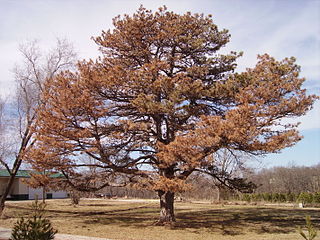
A wilt disease is any number of diseases that affect the vascular system of plants. Attacks by fungi, bacteria, and nematodes can cause rapid killing of plants, large tree branches or even entire trees. Plants have viruses too.

Monochamus scutellatus, commonly known as the white-spotted sawyer or spruce sawyer or spruce bug, is a common wood-boring beetle found throughout North America. It is a species native to North America.

The black-eared catbird is a species of bowerbird (Ptilonorhynchidae) which can be found northern Queensland and New Guinea, including its surrounding islands. They are named after their cat-like wails and black ear spot. It is described by its Latin name: ailur-cat, oidos-singing, melas-black and otus-ear.

The Arfak catbird is a species of bowerbird (Ptilonorhynchidae) which can be found in the Bird's Head (Vogelkop) Peninsula in western New Guinea.
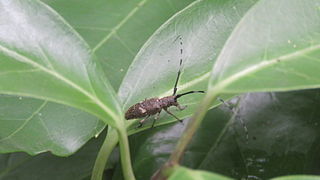
Monochamus subfasciatus is a species of beetle in the family Cerambycidae. It was described by Henry Walter Bates in 1873. It is recorded from Japan where it infests Japanese red pine and is a vector of the nematode Bursaphelenchus doui.

Monochamus alternatus, the Japanese pine sawyer, is a species of beetle in the family Cerambycidae. It was described by Frederick William Hope in 1842. It is known from Hong Kong, Vietnam, Laos, North Korea, South Korea, Japan, China, and Taiwan. It feeds on Pinus banksiana, Abies firma, Pinus armandii, Pinus massoniana, and Pinus densiflora. It serves as a vector for the nematode Bursaphelenchus xylophilus.
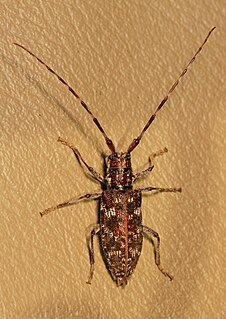
The spotted pine sawyer is a species of beetle in the family Cerambycidae. It was described by John Lawrence LeConte in 1852.

Monochamus galloprovincialis, the pine sawyer beetle, also referred to as the black pine sawyer beetle, is a species of beetle in the family Cerambycidae. It was described by Olivier in 1795, originally under the genus Cerambyx. It has a wide distribution, occurring naturally throughout Europe and the Caucasus. It has also been introduced into the Canary Islands. It serves as a vector for the parasitic nematode species Bursaphelenchus xylophilus, and also acts as a host to the parasitoid wasp species Dolichomitus tuberculatus.
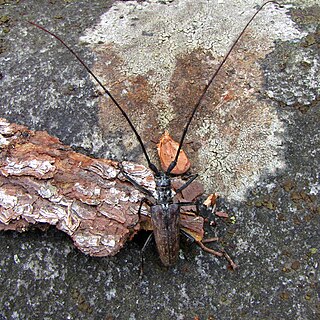
Monochamus notatus, the northeastern pine sawyer or notable sawyer, is a species of beetle in the family Cerambycidae. It was described by Dru Drury in 1773, originally under the genus Cerambyx. It is known from Canada and the United States.

Monochamus sartor is a species of beetle in the family Cerambycidae. It was described by Johan Christian Fabricius in 1787, originally under the genus Lamia. It is known from throughout Europe, as well as in Kazakhstan, Mongolia, North Korea and South Korea. It is rated by the IUCN as Least Concern.
Monochamus titillator is a species of beetle in the family Cerambycidae. It was described by Johan Christian Fabricius in 1775. It is known from the United States.


















